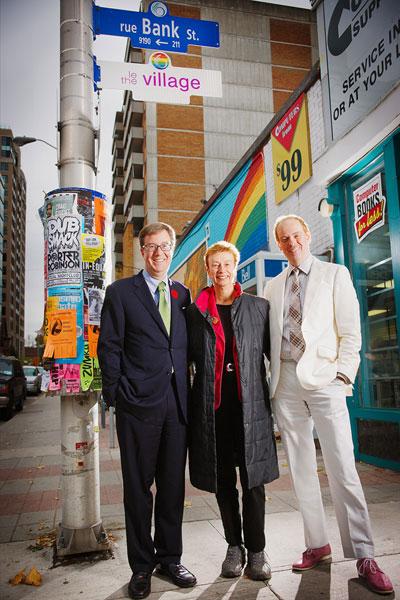Mayor Jim Watson, Councillor Diane Holmes and Glenn Crawford, chair of The Village committee, gathered on Bank St for an official photo to celebrate Ottawa’s new gay village.
“This was something in the campaign that I was asked if I would support, putting up the signs. I gave that commitment that I would; I thought it was a great idea. It shows how inclusive and open our society is, and I think the signs look great,” Watson says.
***
It is official. Ottawa has a gay village.
After six years, three surveys and dozens of meetings, on Nov 4 the city officially recognized the gay village and put up six signs on Bank St at the corners of Somerset, James and Nepean streets.
“It’s a combination of six years of work,” says Glenn Crawford, chair of The Village committee, which has lobbied for the creation of a gay neighbourhood. “Six years, six signs. Obviously we are thrilled about it; we are really proud. We stuck with it, we were diligent, we had faith that it was something achievable and something that was viable and important.”
In an interview with Xtra, Crawford thanked Councillor Diane Holmes and Mayor Jim Watson for supporting the historic moment.
“Ottawa now joins other world capital cities in having a GLBT-friendly village. This is long overdue considering how progressive a country we live in,” he says.
Holmes has long supported the Bank St Village project. In September, she surveyed residents, asking how they felt about zoning, on six blocks along Bank St from James to Nepean streets.
“I am pleased that [the signs] have gone up. There has been a great deal of support from the residential neighbourhood and, of course, the GLBT community,” she says. “Of the many questionnaires and surveys that have been done, many of them have the majority of respondents in favour.”
Crawford sees the Village signs as a major piece of a larger puzzle. They fulfill the committee’s mandate to gain official recognition of a queer community but are just one step toward the larger goal of growing the area into an even bigger gay neighbourhood.
“You can put up flags and signs, but it has to mean something beyond the symbolism of it. We have proven that there is a community that exists here and that the sky isn’t going to fall if we put a few signs and flags up,” Crawford says.
He says that now the committee can concentrate on marketing the area by talking to businesses about promoting the Village in advertising strategies, encouraging new businesses to move into the area, and liaising with the Bank St Promenade Business Improvement Area (BIA).
“This is maybe an opportunity to discuss with the BIA the next steps, because they have been the organization where there has been the most opposition,” Crawford says. “It is time to talk and work out how that can work together, another part of the puzzle.”
Holmes agrees that having a gay village is a boon for the area’s businesses.
“It has been seen in many cities that court the GLBT community that it is a benefit to businesses,” she says. “[GLBT community members] have more disposable income and they increase the property values in the area, so I am expecting it to be a benefit to the Bank St businesses.”
Crawford also sees the Village as integral to building greater awareness of queer issues.
“Unfortunately, we just had the suicide of Jamie Hubley, and I think that brings to light a real sense of how much our society has to catch up to gay rights and acceptance of the gay community in the wider community,” Crawford says.

 Why you can trust Xtra
Why you can trust Xtra


